预约演示
Novartis' Pluvicto readout is causing trouble for Eli Lilly’s $1.4B radiotherapy buy
临床3期并购临床结果
Despite some investor hesitance, Eli Lilly has already priced in a successful phase 3 readout in its $1.4 billion offer for Point Biopharma, Lilly's oncology chief Jake Van Naarden said.
By the end ElitLillynth, however, many Point investors have developed new thoughts.Point Biopharma Global
Fast forward to Monday, Dec. 4, Lilly pushed back the deadline of its tender offer for Point’s shares for a second time. This time, only 24.75% of Point shares had been tendered, even lower than the 26.45% Lilly previously collected as of Nov. 16.
“The idea that there is some Goldilocks scenario where this product coLillyelyLoxos this massive market unchallenged, I think that is actually the thesis that’s sort of playing out with some of these investors,” added David Hyman, M.D., who recently expanded his oncology development role to chief medical officer at Lilly.
The two executives were referring to Point’s lead candidate, PNT2002, a PSMA-targeted radioligand therapy that has an “imminent” readout expected from a phase 3 trial in metastatic castration-resistant prostate cancer (mCRPC) after second-line hormonal treatment.Lilly
By Van Naarden’s account, Lilly’s current predicament is causPNT2002by aPSMAnternal factors but by Point’s rival, Novartis.metastatic castration-resistant prostate cancer (mCRPC)
AtNovartisopean Society for Medical Oncology 2023 Congress in October, Novartis unveiled phase 3 data for its PSMA-targeted Pluvicto in mCRPC before taxane-based chemotherapy. While Pluvicto showed a massive tumor progression benefit against a change of androgen receptor inhibitor, a preliminary but negative trend of overall survival was observed. As a result, Novartis has decided to delay a potential FDA filing, pending longer follow-up of the PSMAfore trial.
PNT2002 is very similar to Pluvicto, and Point’s SPLASH trial is similaNovartisAfore. Apparently, some investoPSMAre bankingPluvictoscenmCRPCwhere SPtaxane overall survival readout tPluvicto in favor of PNT20tumorut Van Naarden argued that, just like theandrogen receptor, whatever overall survival data SPLASH may produce at the end of the year would be immatureNovartisically “uninterpretable.”FDA
PNT2002the Point study readPluvictond it has a primary endpoint hazard ratio in the range of Novartis’, which I think is very reasonable to assume—that is what we underwrote for our deal, we’ve already vPNT2002hat. And if the hazard ratio on survival, instead of being like 1.1, is 0.9, like, who cares?” Van Naarden said. “Because the truth of the matter is that given the timeline associated here, it’s pretty likely FDA will end up asking for another refresh [of data] anyway prior to filing […] This is sort of a waystation on the path, and I don’t know how informative it really is.”
When the Point deal was announced in early October, analysts at Leerink Partners said the $12Novartisce price “fairly” values the commercial potential of PNT2002 and “represents approximately the upper end of” where Point’s stock price could trade in the best-case scenario from the SPLASH/PSMAfore readouts.FDA
After Novartis’ data release, the Leerink team laid out reasons why SPLASH might show a better overall survival result. To explain the disappointing surviPNT2002wing with Pluvicto, Novartis pointed to a high number of patients who had crossed over from the control arm to the radiotherapy. By comparison, SPLASH may have a lower crossover rate because PNT2002 is not an FDA-approved agent, the Leerink team said.
'Significant upside'
Closing the Lilly deal before the imminent SPLASH readout “is not in the best interest” of Point’s shareholders, Biotechnology Value Fund, a private investment firm that holds about 16.4% of Point’s shares, said in a securities filing in early November.
Lilly’s proposal excluded a negative readout from the SPLASH study as a potential trigger for a material adverse effect clause that allows Lilly to back out of the deal, BVF noted. As such, BVF sees “negligible downside and the potential for significant upside” for the Point shareholders to wait for the SPLASH results.
“ThLillyas never aPluvictofor this deal that we could ‘win this space’ with this medPNT2002because it’s not fundamentally that different of a medicine, that’s the truth,” Lilly’s Hyman said. He predicted that both drugs will eventually get approved in the pre-taxane mCRPC setting and will split the market.
How hard the Point investors are fighting the deal also puzzles Van Naarden and Hyman because Point won’t book the full financials from PNT2002. Last November, Point out-lLillyed commercialization rights to PNT2002 and another candidate to Lantheus. After certain commercial milestone payments, Point will get 20% royalties on PNT2002’s sales.
With the PSMA asset already baked in, Lilly is buying Point for its broader radiotherapy capabilities, Van NaaLantheusd.
“We did tPSMAPSMAeal because we think thatLillyioligand therapy] technology is coming to a place of real clinical importance for patients and a commercial reality that is real,” Van Naarden said. “It’s a modality that we were gonna have a hard time building on our own because of the complex supply chain and manufacturing.”
“In the face of rapid change and uncertainty, one of the ways to mitigate that is just to diversify the technologies you have in your toolkit so that you can reach for different things, depending on how the ground shifts beneath you,” Van Naarden said of the current oncology landscape.
Lilly now has two options, according to Van Naarden. The company can continue to push back the tender offer until summer 2024 per the merger agreement or choose to pay a fee and walk away.
Lillyasked whether Lilly would pay more, the Loxo chief said: “We valued the company, we valued success. I don’t know what else there is to pay for.”
更多内容,请访问原始网站
文中所述内容并不反映新药情报库及其所属公司任何意见及观点,如有版权侵扰或错误之处,请及时联系我们,我们会在24小时内配合处理。
Eureka LS:
全新生物医药AI Agent 覆盖科研全链路,让突破性发现快人一步
立即开始免费试用!
智慧芽新药情报库是智慧芽专为生命科学人士构建的基于AI的创新药情报平台,助您全方位提升您的研发与决策效率。
立即开始数据试用!
智慧芽新药库数据也通过智慧芽数据服务平台,以API或者数据包形式对外开放,助您更加充分利用智慧芽新药情报信息。




